The South African Railways Class 25NC 4-8-4 of 1953 was a class of steam locomotives built between 1953 and 1955 for the South African Railways (SAR). The Class 25NC was the non-condensing version of the Class 25 condensing locomotive, of which ninety were placed in service at the same time. Between 1973 and 1980, all but three of the condensing locomotives were converted to non-condensing and also designated Class 25NC.[1][2]
Manufacturers


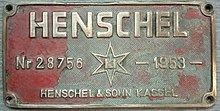
The Class 25NC non-condensing and Class 25 condensing 4-8-4 Northern type steam locomotives were designed by the South African Railways (SAR) under the direction of LC Grubb, Chief Mechanical Engineer of the SAR from 1949 to 1954, in conjunction with Henschel & Son of Kassel in Germany who designed the condensing apparatus and the condensing tender of the Class 25 sister locomotive.[3] Between 1953 and 1955,eleven Class 25NC locomotives were built by the North British Locomotive Company (NBL) and numbered in the range from 3401 to 3411 while 39 locomotives were built by Henschel and numbered in the range from 3412 to 3450.[4][5][6]
Characteristics
The Class 25NC was superheated and used piston valves actuated by Walschaerts valve gear. Timken roller bearings were used throughout, including on the three-axle tender bogies, the coupling and connecting rods as well as the crosshead gudgeon pins, while the locomotive's leading bogies and coupled wheels had Cannon-type axle boxes. Compared to earlier SAR practice, a novelty was the adoption of mechanical lubrication. A sixteen-feed lubricator was driven off the expansion link trunnion. The cylinders and frames were cast in one piece by Commonwealth Steel Company in the United States. The steel cylinders and steam chests were fitted with cast iron liners. Being entirely mounted on roller bearings, very little effort was required to move these locomotives.[1][7][8][9][10]
The Alligator type crossheads were split on the vertical centre line and clamped on to the end of the piston rods, which had three coned rings engaging in grooves in the crossheads. The original coupling rods differed from the usual in being three separate rods, thereby doing away with four knuckle joints and pins.[1]
The multiple-valve superheater header was of the Melesco type. The boiler was fitted with four Ross-pop safety valves, each 2+1⁄2 inches (64 millimetres) in diameter, and two Hopkinson boiler blowdown cocks on the firebox wrapper, one on each side. Feedwater was delivered to the boiler by two Friedmann vertical type non-lifting injectors, each with a capacity of 5,200 imperial gallons (23,600 litres; 6,240 US gallons) per hour.[7]
The locomotive was equipped with a Type EW1 tender which was equipped with a mechanical stoker of which the engine was mounted on the tender. The tank had a water capacity of 10,500 imperial gallons (47,700 litres; 12,600 US gallons) and the coal bunker a capacity of 18 long tons (18.3 tonnes; 20.2 short tons). The tender frame was also a one-piece steel casting and was a water-bottom frame, with the frame itself forming the bottom of the tank instead of being a separate tank and frame as in previous designs.[1][11]
Teething troubles
Soon after entering service, problems were experienced with failing connecting rods, big end bearings breaking up as well as cracks developing in the motion girder of the Alligator crossheads. After investigations by SAR engineers with assistance from the South African Council for Scientific and Industrial Research, the crossheads, slide bars and coupling rods were modified. The crossheads were converted to the multiple-bearing type with single guide bars while the three independent coupling rods were replaced with the more conventional single coupling rod with knuckle joints.[1][12][10]
When new, the tapered Timken crankpin roller bearings soon became notorious for throwing their lubricant onto the underside of the boiler, from where it ran down to the lowest point and dripped onto the coupled wheel tyres along the way. This manufacturer's fault also applied to the Class 25 and was one of the reasons for the reputation of both classes of being slippery. Timken managed to resolve the problem before all their bearings had been replaced, but by then about two-thirds of the locomotives had already been fitted with redesigned coupling rods with SKF crankpin ball bearings.[10]
Service

The Class 25NC initially served on the unelectrified mainlines from De Aar via Kimberley to Welverdiend. They were pooled from their introduction and were run through from De Aar to Welverdiend and vice versa, recoaling at Warrenton. After electrification was extended from Welverdiend to Klerksdorp, they ran from there to De Aar, still recoaling at Warrenton. Later they also worked from Kimberley via Bloemfontein to Harrismith in the Free State while some joined the Class 25 condensers on the line from De Aar via Beaufort West to Touws River.[4][13]
When the line south from De Aar was dieselised between 1973 and 1974, the Class 25 condensers working there were moved north to work the section from De Aar to Kimberley, where they replaced twenty-two Class 25NCs which were then relocated to Bethlehem in the Free State. From 1982, Class 25NCs also replaced Class 19Ds and Class GMAM Garratts on the line from Warrenton via Vryburg to Mafeking.[14]
Class 25 rebuilding
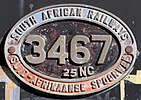
Along with the Class 25NC, ninety Class 25 condensing locomotives were built as part of the same order, one by Henschel and the rest by NBL. The condensing apparatus for these engines and their condensing tenders were designed and patented by Henschel.[1]
Between 1973 and 1980, all but three of the ninety Class 25 condensers were converted to non-condensing locomotives and reclassified to Class 25NC, the exceptions being numbers 3451, 3511 and 3540. The number plates of some were copied and recast with the additional "NC" for "non-condensing" squeezed in next to the existing "25", which resulted in a lopsided class indication on their cabside plates. Locomotives with all four characters neatly in line and centred were therefore usually identifiable as original Class 25NCs.[2][15]
In the process, their Type CZ condensing tenders were also rebuilt to ordinary coal-and-water Type EW2 tenders by removing the condensing radiators and roof fans and replacing it with a massive water tank. Since the Type CZ tenders were built on single cast steel water-bottom frames it was impractical to attempt to shorten them, which resulted in the rebuilt Type EW2 tenders with their long round-topped water tanks. Locomotives with these rebuilt tenders were soon nicknamed Worshond (Sausage dog or Dachshund).[14]
The Class 26 Red Devil
Between 1979 and 1981 no. 3450, the last Class 25NC to be built, was rebuilt to the sole Class 26, the Red Devil, at the SAR workshops at Salt River, Cape Town. The primary objectives of the project were to improve the combustion and steaming rate, to reduce the emission of wasteful black smoke and to overcome the problem of clinkering.[16][17][18][19]
This was achieved by the use of a Gas Producer Combustion System, which relies on the gasification of coal on a low temperature firebed so that the gases are then fully burnt above the firebed. These extensive modifications justified reclassification and the locomotive became the first and only Class 26, although the locomotive's original Class 25NC number was retained.[16][17]
Preservation
The following is a list of 25NC and 26 class that have survived into preservation.
Most are still owned by the Transnet Heritage Foundation. None except the class 25Nc 3437 & 25Nc 3482 (and it only for the winter months) are mainline certified as of 1 January 2019.
| Number (*EW2 tenders) | Works number | Transnet Heritage Foundation / Private | Leaselend / Owner | Current Location | Notes |
|---|---|---|---|---|---|
| 3404 | NBL 27290 | Transnet Heritage Foundation | Germiston Locomotive Depot | ||
| 3405 | NBL 27291 | Private | Quainton Railway Society[20] | Buckinghamshire Railway Centre, England | Repatriated 1991 |
| 3407* | NBL 27293 | Private | Greg McLennan | Worcester Locomotive Depot | |
| 3410 | NBL 27296 | Transnet Heritage Foundation | Transnet Heritage Foundation | Bloemfontein Locomotive Depot | Selected as Transnet Heritage Foundation representative of the class (National Collection) |
| 3411 | NBL 27311 | Transnet Heritage Foundation | Museum | Kimberley station | |
| 3422 | Hensc 28741 | Transnet Heritage Foundation | Cape Town station | ||
| 3432 | Hensc 28751 | Private | Mainline Steam Heritage Trust[21] | Auckland, New Zealand | Exported 1996 |
| 3437* | Hensc 28752 | Private | Oscar Sabitini | Kimberley Locomotive Depot |
Passed boiler test June 2023 Operational |
| 3441* | Hensc 28760 | Transnet Heritage Foundation | Steamnet 2000 | Kimberley Locomotive Depot | |
| 3442* | Hensc 28761 | Private | Rovos Rail | Capital Park Locomotive Depot | Named Anthea |
| 3454* | NBL 27314 | Transnet Heritage Foundation | Mainline Steam | Bloemfontein Locomotive Depot | |
| 3457* | NBL 27317 | Transnet Heritage Foundation | Steamnet 2000 | Kimberley Locomotive Depot | |
| 3467 | NBL 27327 | Transnet Heritage Foundation | Steamnet 2000 | Kimberley Locomotive Depot | |
| 3472 | NBL 27331 | Transnet Heritage Foundation | Germiston Locomotive Depot | ||
| 3476 | NBL 27336 | Transnet Heritage Foundation | Mainline Steam | Waterval Boven | |
| 3480 | NBL 27340 | Private | Rovos Rail | Capital Park Locomotive Depot | Scrapped |
| 3482 | NBL 27342 | Transnet Heritage Foundation | Steamnet 2000 | Kimberley Locomotive Depot | Passed boiler test June 2023
Operational |
| 3488* | NBL 27348 | Private | Sandstone Estates[22] | Sandstone Estate, Ficksburg | |
| 3496 | NBL 27356 | Transnet Heritage Foundation | Sandstone Estates[23] | Sandstone Estate | |
| 3501* | NBL 2731 | Transnet Heritage Foundation | Kimberley Locomotive Depot | ||
| 3508 | NBL 27368 | Private | Mainline Steam Heritage Trust[21] | Auckland, New Zealand | Exported 1996 |
| 3533* | NBL 27393 | Private | Rovos Rail | Capital Park Locomotive Depot | Named King Zog |
| 3536 | NBL 27396 | Transnet Heritage Foundation | Sandstone Estates[23] | Sandstone Estate | |
| 3537 | NBL 27397 | Private | Kimberley Locomotive Depot | ||
| 3450 | Hensc 28397 | Transnet Heritage Foundation | Ceres Railway Company[24] | Royal Cape Yacht Club | Operational |
Project Zimbabwe
During 1988 a severe motive power shortage was experienced by the National Railways of Zimbabwe and discussions with South Africa revealed that numerous class 25NC 4-8-4, had been recently withdrawn from service and were available for either hire or purchase. NRZ decided to investigate the purchase of 20 to 25 of these locomotives for a short-term basis. A team of three were sent down from Bulawayo inspected 50 locomotives at Warrenton and De Aar.
A list of 28 locomotives was submitted from which it would be possible to choose 20 to 25, or any lesser number which might be needed
Category A (locomotives with 5 or more years before heavy overhaul)
3404, 3410, 3422, 3428, 3438, 3442, 3445, 3453, 3457, 3459, 3479, 3504, 3508, 3519
Category B (needing heavy repairs by 1993–1994)
3412, 3424, 3464, 3473, 3475, 3490, 3498, 3507, 3518, 3520, 3537
Category C (needing heavy repairs by 1992)
3439, 3446, 3515
The project did not materialise but several did survive into preservation.
Works numbers
The locomotive numbers, builders and works numbers are listed in the table. On the builders' works lists, all the locomotives are shown as having been built in 1953. All tenders bore the same works number as the engines they were built with, except the sixty tenders which were built by Henschel for condensing engines which were built by NBL. These sixty tenders were allocated Henschel works numbers.[1][11][25][26]
Loco no |
Builder |
Works no |
Tender Builder |
Tender Works no |
Rebuilt Date from class 25 to class 25nc |
Date and Place Scrapped |
|---|---|---|---|---|---|---|
| 3401 | NBL | 27287 | 2007 Bethlehem | |||
| 3402 | NBL | 27288 | 1986 Bloemfontein Works | |||
| 3403 | NBL | 27289 | 2007 Bloemfontein | |||
| 3404 | NBL | 27290 | ||||
| 3405 | NBL | 27291 | ||||
| 3406 | NBL | 27292 | 1983 Bloemfontein Works | |||
| 3407 | NBL | 27293 | ||||
| 3408 | NBL | 27294 | 2007 Bethlehem | |||
| 3409 | NBL | 27295 | 2010 Jan Kempdorp | |||
| 3410 | NBL | 27296 | ||||
| 3411 | NBL | 27311 | ||||
| 3412 | Henschel | 28731 | 2007 Bloemfontein | |||
| 3413 | Henschel | 28732 | 2007 Bethlehem | |||
| 3414 | Henschel | 28733 | 2008 Krugerersdorp | |||
| 3415 | Henschel | 28734 | 2007 Bethlehem | |||
| 3416 | Henschel | 28735 | 1983 Bloemfontein Works | |||
| 3417 | Henschel | 28736 | 2016 Worcester | |||
| 3418 | Henschel | 28737 | 2007 Bethlehem | |||
| 3419 | Henschel | 28738 | 2007 Bethlehem | |||
| 3420 | Henschel | 28739 | 2007 Bethlehem | |||
| 3421 | Henschel | 28740 | 2007 Bethlehem | |||
| 3422 | Henschel | 28741 | ||||
| 3423 | Henschel | 28742 | 1993 De Aar | |||
| 3424 | Henschel | 28743 | 1993 De Aar | |||
| 3425 | Henschel | 28744 | 2007 Kimberley | |||
| 3426 | Henschel | 28745 | 2007 Kimberley | |||
| 3427 | Henschel | 28746 | 2007 Kimberley | |||
| 3428 | Henschel | 28747 | 1993 De Aar | |||
| 3429 | Henschel | 28748 | 1993 De Aar | |||
| 3430 | Henschel | 28749 | 1993 De Aar | |||
| 3431 | Henschel | 28750 | 2007 Bethlehem | |||
| 3432 | Henschel | 28751 | ||||
| 3433 | Henschel | 28752 | 1985 Bloemfontein Works | |||
| 3434 | Henschel | 28753 | 1993 De Aar | |||
| 3435 | Henschel | 28754 | 2007 Warrenton | |||
| 3436 | Henschel | 28755 | 1993 De Aar | |||
| 3437 | Henschel | 28756 | ||||
| 3438 | Henschel | 28757 | 2010 Jan Kempdorp | |||
| 3439 | Henschel | 28758 | 2007 Warrenton | |||
| 3440 | Henschel | 28759 | ||||
| 3441 | Henschel | 28760 | ||||
| 3442 | Henschel | 28761 | ||||
| 3443 | Henschel | 28762 | 2007 Kimberley | |||
| 3444 | Henschel | 28763 | 2007 Kimberley | |||
| 3445 | Henschel | 28764 | 2007 Warrenton | |||
| 3446 | Henschel | 28765 | 2007 Warrenton | |||
| 3447 | Henschel | 28766 | 2007 Kimberley | |||
| 3448 | Henschel | 28767 | 2007 Kimberley | |||
| 3449 | Henschel | 28768 | 2007 Kimberley | |||
| 3450 | Henschel | 28769 | Class 26 Red Devil | |||
| 3452 | NBL | 27312 | Henschel | 28780 | 1976-09 | 1993 De Aar |
| 3453 | NBL | 27313 | Henschel | 28781 | 1977-11 | 2010 Jan Kempdorp |
| 3454 | NBL | 27314 | Henschel | 28782 | 1977-06 | |
| 3455 | NBL | 27315 | Henschel | 28783 | 1975-09 | 1993 De Aar |
| 3456 | NBL | 27316 | Henschel | 28784 | 1976-07 | 2007 Kimberley |
| 3457 | NBL | 27317 | Henschel | 28785 | 1978-01 | |
| 3458 | NBL | 27318 | Henschel | 28786 | 1975-01 | 1993 De Aar |
| 3459 | NBL | 27319 | Henschel | 28787 | XX | 2007 Warrenton |
| 3460 | NBL | 27320 | Henschel | 28788 | XX | 2007 Kimberley |
| 3461 | NBL | 27321 | Henschel | 28789 | 1975-10 | 1983 Salt River |
| 3462 | NBL | 27322 | Henschel | 28790 | 1979-12 | 2007 Warrenton |
| 3463 | NBL | 27323 | Henschel | 28791 | XX | 1987 Bloemfontein Works |
| 3464 | NBL | 27324 | Henschel | 28792 | 1976-10 | 2007 Warrenton |
| 3465 | NBL | 27325 | Henschel | 28793 | 1975-06 | 1993 De Aar |
| 3466 | NBL | 27326 | Henschel | 28794 | 1976-04 | 2007 Kimberley |
| 3467 | NBL | 27327 | Henschel | 28795 | 1979-07 | |
| 3468 | NBL | 27328 | Henschel | 28796 | XX | 1993 De Aar |
| 3469 | NBL | 27329 | Henschel | 28797 | 1979-05 | 2007 Kimberley |
| 3470 | NBL | 27330 | Henschel | 28798 | 1975-06 | 1993 De Aar |
| 3471 | NBL | 27331 | Henschel | 28799 | 1976-05 | 1993 De Aar |
| 3472 | NBL | 27332 | Henschel | 28800 | XX | |
| 3473 | NBL | 27333 | Henschel | 28801 | 1976-07 | 1993 De Aar |
| 3474 | NBL | 27334 | Henschel | 28802 | 1979-04 | 2007 Warrenton |
| 3475 | NBL | 27335 | Henschel | 28803 | 1976-06 | 2007 Bloemfontein |
| 3476 | NBL | 27336 | Henschel | 28804 | 1979-06 | |
| 3477 | NBL | 27337 | Henschel | 28805 | XX | 2007 Warrenton |
| 3478 | NBL | 27338 | Henschel | 28806 | 1978-08 | 2007 Kimberley |
| 3479 | NBL | 27339 | Henschel | 28807 | 1979-05 | 2016 Bloemfontein |
| 3480 | NBL | 27340 | Henschel | 28808 | 1975-05 | |
| 3481 | NBL | 27341 | Henschel | 28809 | 1975-10 | 2008 Dal Josafat |
| 3482 | NBL | 27342 | Henschel | 28810 | 1979-02 | |
| 3483 | NBL | 27343 | Henschel | 28811 | 1975-11 | 2007 Kimberley |
| 3484 | NBL | 27344 | Henschel | 28812 | 1978-05 | |
| 3485 | NBL | 27345 | Henschel | 28813 | 1976-11 | 2007 Kimberley |
| 3486 | NBL | 27346 | Henschel | 28814 | 1976-12 | 2007 Kimberley |
| 3487 | NBL | 27347 | Henschel | 28815 | 1974-11 | 1993 De Aar |
| 3488 | NBL | 27348 | Henschel | 28816 | 1976-08 | |
| 3489 | NBL | 27349 | Henschel | 28817 | 1977-03 | 2007 Warrenton |
| 3490 | NBL | 27350 | Henschel | 28818 | 1976-05 | 2007 Warrenton |
| 3491 | NBL | 27351 | Henschel | 28819 | 1975-02 | 2007 Warrenton |
| 3492 | NBL | 27352 | Henschel | 28820 | 1974-11 | 1993 De Aar |
| 3493 | NBL | 27353 | Henschel | 28821 | 1975-11 | 2007 Kimberley |
| 3494 | NBL | 27354 | Henschel | 28822 | 1975-11 | 2010 Jan Kempdorp |
| 3495 | NBL | 27355 | Henschel | 28823 | 1979-12 | 2007 Warrenton |
| 3496 | NBL | 27356 | Henschel | 28824 | 1978-08 | |
| 3497 | NBL | 27357 | Henschel | 28825 | 1975-02 | 1993 De Aar |
| 3498 | NBL | 27358 | Henschel | 28826 | 1977-01 | 2010 Jan Kempdorp |
| 3499 | NBL | 27359 | Henschel | 28827 | 1975-06 | 2007 Kimberley |
| 3500 | NBL | 27360 | Henschel | 28828 | 1978-02 | 2007 Kimberley |
| 3501 | NBL | 27361 | Henschel | 28829 | 1979-08 | |
| 3502 | NBL | 27362 | Henschel | 28830 | 1976-02 | 2007 Kimberley |
| 3503 | NBL | 27363 | Henschel | 28831 | 1975-05 | 2007 Warrenton |
| 3504 | NBL | 27364 | Henschel | 28832 | 1977-09 | 2007 Warrenton |
| 3505 | NBL | 27365 | Henschel | 28833 | 1981-10 | 2007 Kimberley |
| 3506 | NBL | 27366 | Henschel | 28834 | 1974-12 | 1993 De Aar |
| 3507 | NBL | 27367 | Henschel | 28835 | 1976-10 | 1993 De Aar |
| 3508 | NBL | 27368 | Henschel | 28836 | 1977-03 | |
| 3509 | NBL | 27369 | Henschel | 28837 | 1976-02 | 1993 De Aar |
| 3510 | NBL | 27370 | Henschel | 28838 | 1978-04 | 1987 Bloemfontein Works |
| 3512 | NBL | 27372 | 1974-10 | 1993 De Aar | ||
| 3513 | NBL | 27373 | 1974-07 | 2007 Bloemfontein | ||
| 3514 | NBL | 27374 | 1976-09 | 2007 Kimberley | ||
| 3515 | NBL | 27375 | 1975-08 | 1993 De Aar | ||
| 3516 | NBL | 27376 | 1979-04 | 2007 Kimberley | ||
| 3517 | NBL | 27377 | 1976-03 | 2007 Kimberley | ||
| 3518 | NBL | 27378 | 1977-02 | 2007 Bloemfontein | ||
| 3519 | NBL | 27379 | 1977-02 | 2007 Warrenton | ||
| 3520 | NBL | 27380 | 1976-03 | 2007 Warrenton | ||
| 3521 | NBL | 27381 | 1977-04 | 2007 Warrenton | ||
| 3522 | NBL | 27382 | 1975-12 | 1993 De Aar | ||
| 3523 | NBL | 27383 | 1975-09 | 1993 De Aar | ||
| 3524 | NBL | 27384 | 1979-10 | 2007 Warrenton | ||
| 3525 | NBL | 27385 | 1976-08 | 2007 Kimberley | ||
| 3526 | NBL | 27386 | 1979-01 | 2007 Kimberley | ||
| 3527 | NBL | 27387 | 1978-06 | 2007 Kimberley | ||
| 3528 | NBL | 27388 | 1976-06 | |||
| 3529 | NBL | 27389 | 1976-02 | 2007 Kimberley | ||
| 3530 | NBL | 27390 | 1975-04 | 1993 De Aar | ||
| 3531 | NBL | 27391 | 1979-11 | 2007 Warrenton | ||
| 3532 | NBL | 27392 | 1978-10 | 1987 Bloemfontein Works | ||
| 3533 | NBL | 27393 | 1978-03 | |||
| 3534 | NBL | 27394 | 1976-05 | 2007 Kimberley | ||
| 3535 | NBL | 27395 | 1979-02 | 2007 Kimberley | ||
| 3536 | NBL | 27396 | 1978-11 | |||
| 3537 | NBL | 27397 | 1975-12 | |||
| 3538 | NBL | 27398 | 1978-08 | 1987 Bloemfontein Works | ||
| 3539 | NBL | 27399 | 1979-10 | 2007 Warrenton |
>
Illustration
-
NBL-built no. 3411 relieving electric units on a northbound Trans-Karoo at Beaufort West, Cape Province, 26 June 1966
-
NBL-built no. 3410 Paula making its way to the water tanks at Springfontein in the Free State, c. 1995
-
Preparing Henschel-built no. 3440 to be hauled to Pretoria for restoration by Rovos Rail, Beaconsfield, 25 August 2007
-
Henschel-built no. 3422 Bergrivier, converted to oil-firing, with two type X-20 water tenders on the Union Express, c. 2002
-
SAR-rebuilt Red Devil no. 3450, shortly after being rebuilt to the only Class 26, Pretoria, 25 April 1981
References
- ^ a b c d e f g Holland, D. F. (1972). Steam Locomotives of the South African Railways. Vol. 2: 1910-1955 (1st ed.). Newton Abbott, England: David & Charles. p. 110. ISBN 978-0-7153-5427-8.
- ^ a b South African Railways and Harbours Locomotive Diagram Book, 2'0" & 3'6" Gauge Steam Locomotives, 15 August 1941, as amended
- ^ £27 Million Motive Power Order for South African Railways Railway Transportation March 1952 page 43
- ^ a b Paxton, Leith; Bourne, David (1985). Locomotives of the South African Railways (1st ed.). Cape Town: Struik. pp. 10–11, 77–78. ISBN 0869772112.
- ^ North British Locomotive Company works list, compiled by Austrian locomotive historian Bernhard Schmeiser
- ^ Henschel-Lieferliste (Henschel & Son works list), compiled by Dietmar Stresow
- ^ a b South African Railways 25NC Class Locomotives Railway Gazette 15 May 1953 pages 568/569
- ^ Condensing Locomotives for South Africa Railway Gazette 26 February 1954 pages 237-240
- ^ Pivnic, Les (1970). S.A.R. Class 25NC 4-8-4. South African Transport, October 1970. pp. 548-550.
- ^ a b c Soul of A Railway, System 1, Part 4: Touws River to Beaufort West. Introduction par 4, Caption 3. (Accessed on 27 November 2016)
- ^ a b South African Railways & Harbours/Suid Afrikaanse Spoorweë en Hawens (15 August 1941). Locomotive Diagram Book/Lokomotiefdiagramboek, 2'0" & 3'6" Gauge/Spoorwydte, Steam Locomotives/Stoomlokomotiewe. SAR/SAS Mechanical Department/Werktuigkundige Dept. Drawing Office/Tekenkantoor, Pretoria. pp. VIII, 6a-7a, 20-21, 28-28A.
- ^ Information supplied by R.S. Loubser, son of M.M. Loubser
- ^ Soul of A Railway, System 7, Western Transvaal, based in Johannesburg, Part 26: Braamfontein West to Klerksdorp (home signal) by Les Pivnic, Part 1. Caption 36. (Accessed on 6 May 2017)
- ^ a b Durrant, AE (1989). Twilight of South African Steam (1st ed.). Newton Abbott: David & Charles. pp. 107–109. ISBN 0715386387.
- ^ Frieda steam forward alone Diamond Fields Advertiser 27 March 1986
- ^ a b Gas Producer Combustion System (GPCS)
- ^ a b The Ultimate Steam Page
- ^ South Africa's Red Devil The Railway Magazine issue 963 July 1981 pages 317/318
- ^ Steam Locomotive Development in South Africa Continental Railway Journal issue 64 December 1985 pages 39-43
- ^ 25NC Class 4-8-4 No 3405 Buckinghamshire Railway Centre
- ^ a b Mainline Steam, Auckland Locomotives International issue 97 August 2015 page 30
- ^ Ex SAR no: 3488 North British 27348/1954 Sandstone Estates
- ^ a b Railway Storage facility for 3'6" locomotives and rolling stock Sandstone Estates
- ^ Locomotives Ceres Railway Company
- ^ Condenser fitter Albie Bester's reminiscences
- ^ Sabatini, Richard (2006). South African Locomotive Tender Classification, Compatibility & Allocation (1st ed.) Richard Sabatini, Kimberley, January 2006. pp. 21, 38


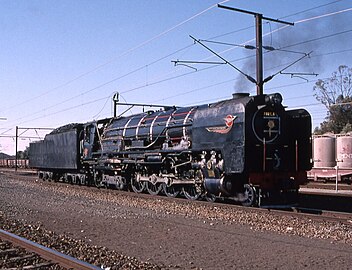

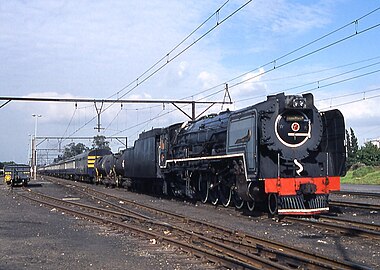
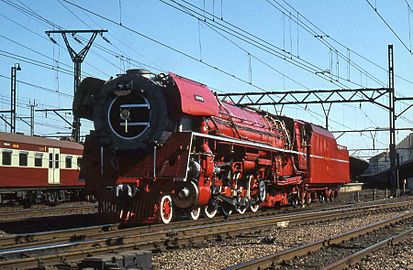

Recent Comments